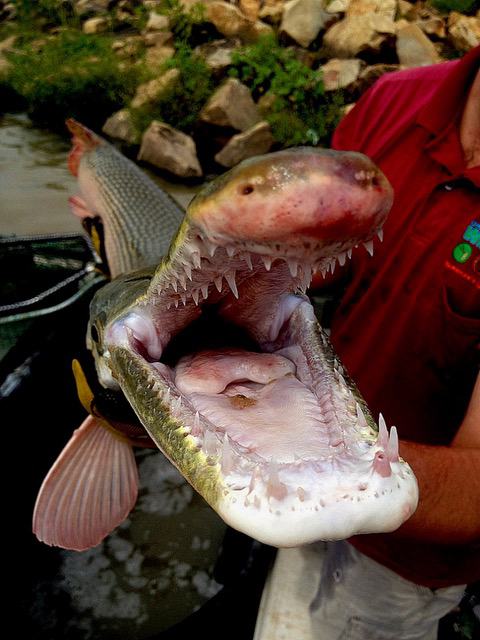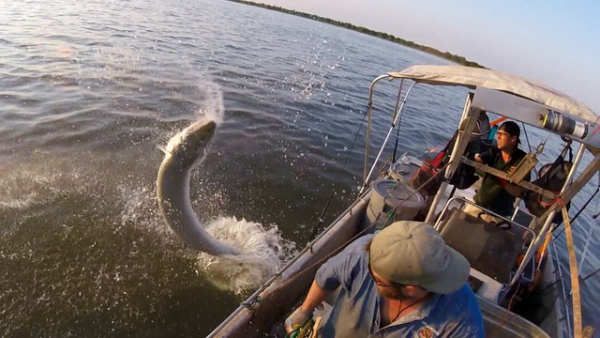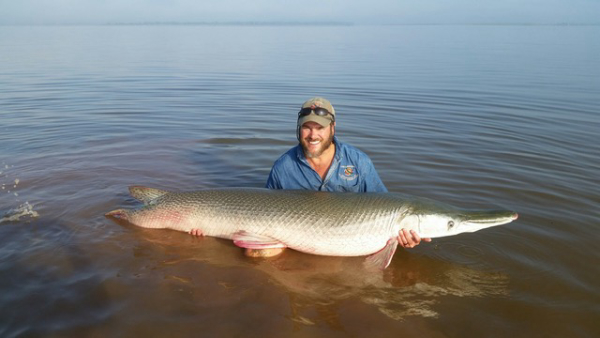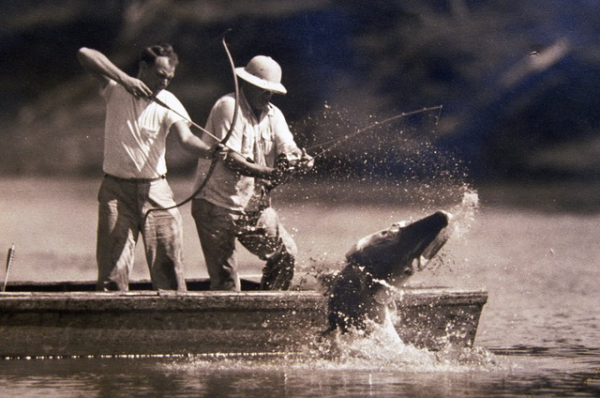
Lake Texoma lies over the Texas - Oklahoma state line. This boundary water is enormous. Denison Dam backs up the Red and Washita rivers for miles. The swollen arms of several tributary streams form massive lake coves that shoulder into the main water body. Consequently, there is much open water and ample shoreline for anglers seeking to catch black basses, crappie, sunfish, blue catfish and white bass.
The striped bass fishery is of good repute. And there is something to say for the alligator gar fishery as well: alligator gar are under-studied.
For anyone with even a perfunctory knowledge of alligator gar, this may seem counter-intuitive—that not a great deal is known about one of the largest freshwater fishes in North America.

Consider this. Alligator gar reach an enormous 13 feet long and fatten to a plump 300 pounds. It’s a long-lived leviathan with some of the eldest individuals swimming this very moment, having hatched when Apollo 10 navigated around the Moon in May of 1969.
These giant fish have a growing, almost cult-like following of anglers, and for good reason. Hook one and hang on. An eight-foot-long alligator gar can take you for a ride. You will see a tail dance in a glistening spray of water akin to a silvery tarpon over turquoise flats in nearshore salt water—except alligator gar potentially have more heft. Get a gator gar to the boat, and with a parting flick of its round tail fin, its sinuous form slips into the murk to be caught again.
Or will it?
That’s a question that Oklahoma Department of Wildlife Conservation (ODWC) research biologist, Richard Snow, seeks to answer.
“Virtually any information we glean from ongoing research is new information,” said Snow from his Norman, Oklahoma, office. Snow is seven years into research into the alligator gar’s life history and has most recently embarked to learn more on a how the fish fairs after being caught and released. The answer to this question is central to sport fishery management and has applicability well beyond the bounds of the Oklahoma state line.
The U.S. Fish and Wildlife Service’s Wildlife and Sport Fish Restoration Program funds Snow’s research—the monies derived from excise taxes paid by tackle manufacturers and then apportioned to state wildlife agencies for essential conservation work such as his.
Snow, an Oklahoma native, has had a years-long personal and professional interest in the fish. He has long enjoyed fishing for alligator gar. He earned a graduate degree at Oklahoma State University in natural resource ecology and management where he researched how to age the fish through its ear bones. The bones, called otoliths, lay down rings much like the cross section of a tree.
Snow says he also earned something else in graduate school. “I have a greater respect for the species—they’re a primitive fish, a swimming fossil that survive from long ago,” said Snow. “They are a remarkable fish—heavily armored on the outside like a tank because their insides are sensitive.”
Now, as an ODWC research biologist, Snow has waded deeper into questions associated with catch-and-release mortality, food preference studies, and growth rates.

Snow set up a hooking study with hefty captive alligator gar held in large ponds at Tishomingo National Fish Hatchery. He catches alligator gar just as anglers do at Lake Texoma and elsewhere, fishing with carp or buffalo fish heads. In the experiments, Snow allows gar to run with bait, played for 30 minutes and brought ashore, examined for noticeable internal injuries such as bleeding or air loss from the vent. The controlled environment allows him to monitor the wellbeing of the fish over a long period to detect effects of hooking that would not otherwise be noted in wild fish. The work is ongoing and results yet to be determined.
Along about May of the year, mature alligator gar move into shallow weedy coves of Lake Texoma and broadcast their eggs that adhere to vegetation. That act is replicated in tanks at the national fish hatchery where he and hatchery staff monitor the young gar.
“Alligator gar have explosive growth in their first year of life,” said Snow. “In the span of only nine days, they go from egg to a larvae with a sucker-disc on its head, and then to a predator. They pack on weight and by the end of the first growing season they’re a foot and half long.”
Alligator gar eat other fish. In examining stomach contents of adult gar, Snow determined that sport fish species make up very little of the diet. Their common foods include common carp, river carpsucker, buffalo species, gizzard shad and white bass.
“These predators typically ambush their prey, but they also actively forage or scavenge their food,” said Snow. “In the heat of the summer when oxygen is low, they gulp air into a highly vascularized swim bladder to ‘breathe.’ Bowfishers and anglers take advantage of these habits to locate alligator gar.”

Snow says the ongoing research will help his agency steer alligator gar fisheries toward sustainability.
Cliff Schleusner, Chief of the Wildlife and Sport Fish Restoration Program, Southwest Region agrees. “These Holocene hold-overs have been understudied and the angler-funded work underway by the Oklahoma Department of Wildlife Conservation adds to a woefully scant body of knowledge,” said Schleusner. “Alligator gar, an apex predator, provide an ecological balance that regulate the populations of other fish species—not to mention an angling experience unequaled.”
-- Craig Springer, External Affairs, U.S. Fish and Wildlife Service – Southwest Region